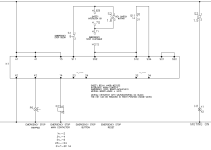rQx
Lifetime Supporting Member
Hi,
Need a little bit guiding using SISTEMA software. As I understand a subsystem consist of components and are the same category. I'm confused because when I build a system in Safety Automation BUilder from rockwell it just enters all components as subsystem which I think is wrong.
So if I have Inputs, Logic and Output all beeing PLc.
The Logic (safety relay) is a encapsuled safety system and is therefore a seperate subsystem.All input and output in this case is PLc and can be grouped into a subsystem.
Is this correct statement?
I'm also a little but unsure about if I need to have all interlocks represented. They are activated all at the same time so I think I have to, if they wouldn't operate att the same time I could have them as "one" just like the e-stop? It fullfills my PLr so it's not an problem but it would be nice to have it the right way.

Need a little bit guiding using SISTEMA software. As I understand a subsystem consist of components and are the same category. I'm confused because when I build a system in Safety Automation BUilder from rockwell it just enters all components as subsystem which I think is wrong.
So if I have Inputs, Logic and Output all beeing PLc.
The Logic (safety relay) is a encapsuled safety system and is therefore a seperate subsystem.All input and output in this case is PLc and can be grouped into a subsystem.
Is this correct statement?
I'm also a little but unsure about if I need to have all interlocks represented. They are activated all at the same time so I think I have to, if they wouldn't operate att the same time I could have them as "one" just like the e-stop? It fullfills my PLr so it's not an problem but it would be nice to have it the right way.







